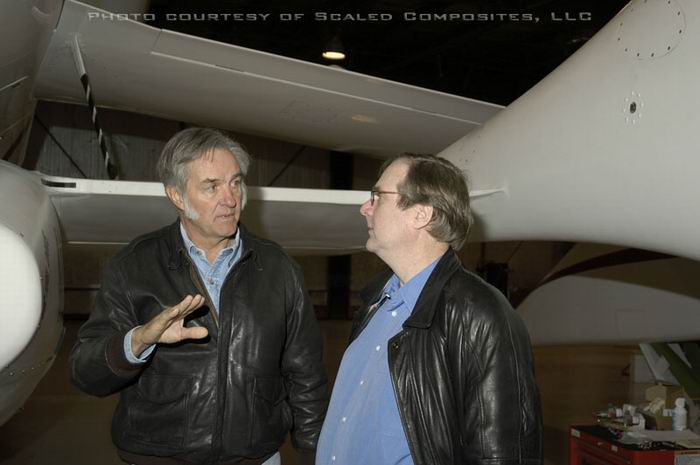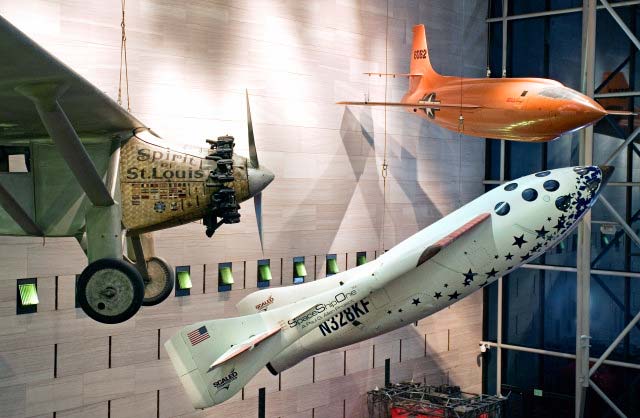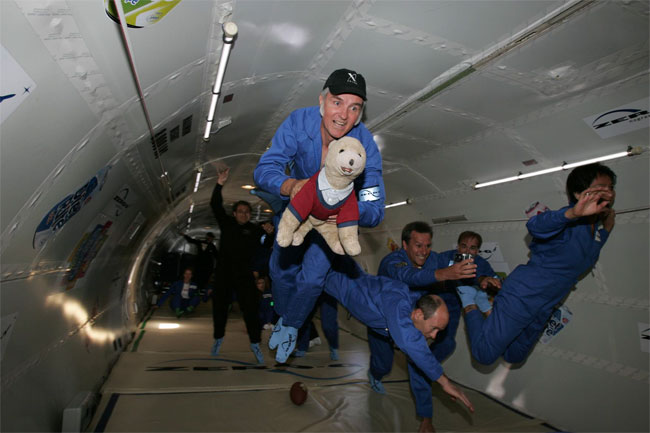Burt Rutan: Scaled Composites Founder
Burt Rutan is the founder of Scaled Composites, which is helping to build SpaceShipTwo– Virgin Galactic's spaceship for tourists to experience suborbital flights.
He and his company vaulted into the public attention in the 1980s. His aircraft – the Rutan Voyager – became the first to fly around the world without stopping or refuelling in 1986.
In spaceflight, Rutan's most prominent success was designing SpaceShipOne, the spacecraft that made it into space twice and won the Ansari X-Prize. It was the first non-governmental human spacecraft to make the journey.
Although Rutan retired from Scaled Composites in 2011, his legacy continues. The SpaceShipTwo spacecraft – the successor for SpaceShipOne – is aiming to begin its first flights around 2014. It will carry tourists from Virgin Galactic, which also has a hand in the spacecraft's manufacturing.
Four of Rutan's designed aircraft and spacecraft are on display at the Smithsonian National Air and Space Museum in Washington, D.C., including Voyager and SpaceShipOne. The museum's airport annex hosts Rutan's Virgin Atlantic GlobalFlyer.
Hobby flying and round-the-world trips
For a man who spent so much of his life working in the high-tech field of aerospace, Rutan spent his childhood in a more low-tech environment. He was born in 1943, and grew up in a farm in a rural area southeast of Portland, Oregon. The family home reportedly had no plumbing.
Breaking space news, the latest updates on rocket launches, skywatching events and more!
However, his father – a dentist – partially owned a private airplane, providing the young Rutan an avenue to explore his love of flight. (Rutan's siblings are also in the aviation industry.) He did his first solo in 1959, according to a Massachusetts Institute of Technology biography, and was third in his class of aeronautical engineers at the California Institute of Technology in 1965.
Rutan spent his early career at Edwards Air Force Base, working on several flight test programs for the U.S. Air Force until 1972. Two years later, he founded his first company: Rutan Aircraft Factory. Working mainly with two-seat aircraft, Rutan's designs were used by everyone from private hobbyists to NASA.
In 1986, Burt's brother Dick and aviator Jeana Yeager piloted one of Rutan's planes all the way around the world without stopping or refuelling. The Voyager aircraft, as it was known, spent more than nine days in flight.
The feat garnered the team the prestigious aerospace Collier Trophy in 1986. Funny enough, Rutan was also behind another successful attempt to do this in 2005. Steve Fossett's two days in flight in Rutan's Virgin Atlantic GlobalFlyer smashed the previous record. The GlobalFlyer ultimately made it three times around the world on separate flights before being retired.
SpaceShipOne success
In spaceflight, Rutan had a vision of launching in a different fashion than the usual rockets. Under his company Scaled Composites (founded in 1982), Rutan's team sketched out a design to bring the spaceship under a carrier aircraft and launch, so to speak, from mid-air.
Rutan convinced Microsoft co-founder Paul Allen to invest in the project, giving Scaled a legitimate shot at having the resources available to pursue the Ansari X-Prize. Shortly before Rutan's design won the prize in 2004, Virgin founder Richard Branson announced plans to run a space tourism company using a successor spaceship.
"We hope to create thousands of astronauts over the next few years and bring alive their dream of seeing the majestic beauty of our planet from above, the stars in all their glory and the amazing sensation of weightlessness," Branson said at the time.
"The development will also allow every country in the world to have their own astronauts rather than the privileged few."
Despite the now high-profile attention on Scaled, at least one of Rutan's biographers pointed out that his personality remained the same at his company.
"Burt Rutan has a confident mien that speaks volumes about his achievements," noted Daniel Alef, who did a biographical sketch of Rutan in 2011.
"More so, he retains a warmth and charm that lead all who meet him to see a very humane and easy-going man who is as comfortable with Paul Allen and Sir Richard Branson as with the men in the shop."
Scaled remains involved with the successor spacecraft's development, SpaceShipTwo, but will pull out when the test flights cease and normal operations begin around 2014. Rutan himself retired from Scaled in 2011. On his website, Rutan wrote that he is mostly interested in making himself available for lectures.
More spaceflight work
Although Rutan is no longer as active at Scaled, he's still involved in space exploration in other ventures. He recently joined the board of Stratolaunch Systems, an air-to-orbit launch system that is slated to have its first test flight in 2017.
The company – which also has financial backing from Allen – initially planned a system that would work with a SpaceX rocket. It aimed to bring 6,100 kilograms to low Earth orbit or 2,300 kg into geosynchronous orbit.
Scaled is involved in the project as well, as it is building a 490,000 pound (222,000 kg) "mothership" airplane able to fly up to about 1,500 miles (2,400 km) before releasing the rocket. But the system may undergo some changes amid a shakeup in late 2012. SpaceX announced it would pull out, and Orbital Sciences Corp. is now going to step in to try to keep the project on track.
"We have been engaging Orbital over the past few months and have them under a study contract through early next year with specific design deliverables," Stratolaunch chief executive Gary Wentz wrote in a November 2012 e-mail to SPACE.com partner Space News.
The companies provided few details about the potential pact. "They are currently evaluating several alternative configurations that appear promising," Wentz added. "We expect more information to be available in the February 2013 timeframe."
Rutan is also keeping busy with an idea for a hybrid flying car, which was revealed publicly amid a short test flight in 2011. Its advertised range is 760 miles (1223 km) in air, and 820 miles (1320 km) when skimming the ground.
The car, also a Scaled project, was unveiled to seek interest from potential customers. Company officials cautioned it was best not to get excited yet, but if it does come true, Rutan could be the architect of the long-held dream of flying cars.
— Elizabeth Howell, SPACE.com Contributor

Elizabeth Howell (she/her), Ph.D., was a staff writer in the spaceflight channel between 2022 and 2024 specializing in Canadian space news. She was contributing writer for Space.com for 10 years from 2012 to 2024. Elizabeth's reporting includes multiple exclusives with the White House, leading world coverage about a lost-and-found space tomato on the International Space Station, witnessing five human spaceflight launches on two continents, flying parabolic, working inside a spacesuit, and participating in a simulated Mars mission. Her latest book, "Why Am I Taller?" (ECW Press, 2022) is co-written with astronaut Dave Williams.



